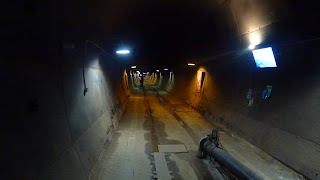In Darwin
Tuesday 30 July
Daytime temps have been 32 degrees but much more bearable than we had imagined.
The Mindil beach market on Sunday evening was an eye-opener. The myriad of food stalls reflected the huge diversity of cultures living here. Maybe 60 different food stalls along with the usual market stalls (which are really quite universal aren’t they). Thousands of people, mostly locals picnicked in the park or on the beach and sat in awe of the fabulous NT sunset. Quite spectacular.
Monday spent off and on the Big Red Explorer bus. Favourite places showcased the two destructions of Darwin - the WW2 bombing and the Hurricane Tracy. The Museum and Art Gallery of NT had a very evocative and in-your -face display telling the horrific story of the Christmas 1974 hurricane which all but wiped Darwin off the map. Only some of the concrete buildings in the CBD remained.
New building codes have resulted in a modern looking city. There are only four pre- cyclone architecture house left, and these are protected as examples of the original Darwin architecture. (similar to the “Queenslanders” on stilts in that state, only taller off the ground.)
The stories of the bombing of Darwin starting 19 February 1942 were kept largely secret from the rest of Australia for many years. Two waves of 270 bombers and fighters destroyed the port, tens of ships, and the airfields both in Darwin and Katherine. but for generations the country was kept in the dark about the true dimensions of the Japanese attack.
We explored the Oil Storage Tunnels in a cliff above the harbour and under the city. Yet another poorly executed (incompetent) war- time story. Eleven large tunnels were planned but only 5 completed because of poor planning, poorer construction techniques, and as usual the “big guns” made a scapegoat of the hapless engineer. They were never used for marine oil but well after the war one was used to store aviation fuel. That is, until seeping waterbetween the concrete casing of the tunnel and the steel tank caused sufficient pressure for the steel tank to split and hundreds of thousands of high octane fuel flowed into the harbour ! Oops. The tunnels remained closed until 1992 hen they we’re open to the public to celebrate 50 years since the bombing of Darwin. Tunnel No 5, which is the only one open to view was 174 metres long, horseshoe shaped 5.4 metres high and 4.5 metres wide. The tunnels were concrete formed and lined with 1/4 “ steel plate.
Collect the m/home tomorrow and head off
Daytime temps have been 32 degrees but much more bearable than we had imagined.
The Mindil beach market on Sunday evening was an eye-opener. The myriad of food stalls reflected the huge diversity of cultures living here. Maybe 60 different food stalls along with the usual market stalls (which are really quite universal aren’t they). Thousands of people, mostly locals picnicked in the park or on the beach and sat in awe of the fabulous NT sunset. Quite spectacular.
Monday spent off and on the Big Red Explorer bus. Favourite places showcased the two destructions of Darwin - the WW2 bombing and the Hurricane Tracy. The Museum and Art Gallery of NT had a very evocative and in-your -face display telling the horrific story of the Christmas 1974 hurricane which all but wiped Darwin off the map. Only some of the concrete buildings in the CBD remained.
New building codes have resulted in a modern looking city. There are only four pre- cyclone architecture house left, and these are protected as examples of the original Darwin architecture. (similar to the “Queenslanders” on stilts in that state, only taller off the ground.)
The stories of the bombing of Darwin starting 19 February 1942 were kept largely secret from the rest of Australia for many years. Two waves of 270 bombers and fighters destroyed the port, tens of ships, and the airfields both in Darwin and Katherine. but for generations the country was kept in the dark about the true dimensions of the Japanese attack.
The holograms and the virtual reality headsets at the museum gave ring-side seats to the first attacks.
 |
Tunnel 5
174 m long, 4.5 m wide and 5.4 m high
(You can’t see the roof in the shadow)
|
Collect the m/home tomorrow and head off

Great accounts of Darwin history. Hope Jill recovered from her Sydney busy time. X
ReplyDeleteYou are bringing back great memories for us. Continue to enjoy and keep the blogs coming
ReplyDeleteEve and Flynn would have put the acoustics to the test in that tunnel.
ReplyDelete